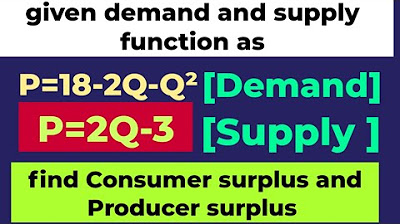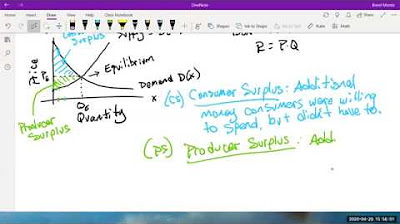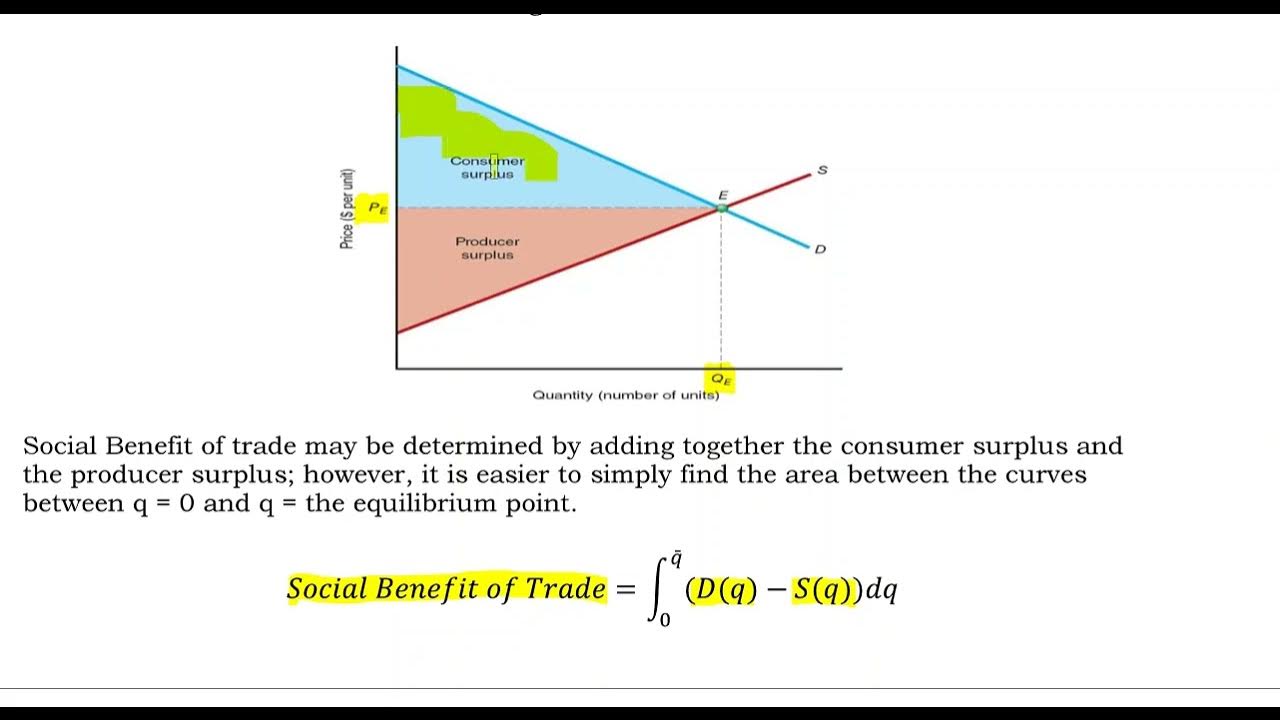Linear Supply Equations - part 1
TLDRThis video lesson explains how to represent the supply of a good, using the example of beef, with a linear supply equation. It demonstrates plotting supply points from a schedule, deriving the supply curve, and calculating the supply equation variables C and D. C represents the quantity intercept, often negative, while D, the price coefficient, measures producers' responsiveness to price changes. The lesson guides through calculating D from price and quantity changes, and finding C to complete the supply equation, illustrating the process with a practical example.
Takeaways
- 📈 The lesson introduces how to represent supply for a good, such as beef, using a linear supply equation.
- 📊 The law of supply is reflected in the increase in quantity supplied as the price of beef increases.
- 📝 The supply schedule for beef is translated into a graph with points plotted at various price levels.
- 📉 The supply curve is drawn as a linear line on the graph, representing the relationship between price and quantity supplied.
- 🔢 The generic supply equation is Qs = C + D * P, where Qs is the quantity supplied, C is the quantity intercept, D is the price coefficient of supply, and P is the price.
- ⚠️ The C variable is usually negative, indicating that no producers are willing to supply the good at a price of zero, except in cases of subsidies.
- 🔄 The D variable represents the responsiveness of producers to price changes and is the inverse of the slope of the supply curve.
- 📐 The D variable is calculated by finding the change in quantity over the change in price between two points on the supply curve.
- 🔑 To find the C variable, a price and quantity combination from the supply schedule is plugged into the supply equation and solved for C.
- 🐂 The complete supply equation for beef is derived as Qs = -40 + 30 * P, showing the quantity supplied of beef at different prices.
- 🔍 The next lesson will discuss calculating the price intercept and the effects of changes in the C and D variables in the supply equation.
Q & A
What is the main topic of the lesson in the provided transcript?
-The main topic of the lesson is to introduce how the supply for a particular good, in this case, beef, can be represented using a linear supply equation.
What is the law of supply mentioned in the script?
-The law of supply states that as the price of a good increases, the quantity that producers are willing and able to supply also increases, ceteris paribus.
How is the supply curve represented in the script?
-The supply curve is represented as a linear curve on a graph, where the quantity supplied of beef increases as the price increases.
What is the generic supply equation presented in the script?
-The generic supply equation is Quantity Supplied = C + D * Price, where C is the quantity intercept and D is the price coefficient of supply.
What does the C variable in the supply equation represent?
-The C variable represents the quantity intercept of the supply curve, which is the quantity that would be supplied at a price of zero, assuming no subsidies or other market interventions.
Why is the C variable usually negative in the supply equation?
-The C variable is usually negative because, at a price of zero, no producers are generally willing or able to supply a good, as production costs are not covered.
What does the D variable in the supply equation represent?
-The D variable, also known as the price coefficient of supply, represents the responsiveness of producers to an increase in the price of the good. It is the inverse of the slope of the supply curve.
How is the D variable calculated in the supply equation?
-The D variable is calculated as the change in quantity over the change in price between two points on the supply curve.
Outlines
📈 Introduction to Linear Supply Equations and Beef Market Analysis
This paragraph introduces the concept of representing supply for a good using a linear supply equation, specifically focusing on the market for beef. It explains how the quantity supplied increases with price, reflecting the law of supply. The paragraph describes the process of plotting supply points from a schedule, drawing a supply curve, and deriving a supply equation from the table and graph. It also discusses the generic supply equation, the variables it contains, and their meanings, such as the quantity intercept (C variable) and the price coefficient of supply (D variable), which measures producers' responsiveness to price changes.
📚 Calculating the Supply Equation for Beef
The second paragraph delves into the process of calculating the D variable in the supply equation using the change in quantity over the change in price from the supply schedule. It demonstrates the calculation with specific points, resulting in a D variable of 30 for the beef supply equation. The paragraph then explains how to find the C variable by using a price and quantity combination from the supply schedule, revealing a negative C variable of -40. This leads to the complete supply equation for beef, which is the quantity supplied equals -40 plus 30 times the price. The summary concludes with a mention of future topics, including calculating the price intercept and the impact of changes in the C and D variables.
Mindmap
Keywords
💡Supply
💡Linear Supply Equation
💡Law of Supply
💡Supply Schedule
💡Supply Curve
💡Quantity Intercept
💡Price Coefficient of Supply (D Variable)
💡Slope
💡Responsiveness
💡Subsidies
💡Derive
Highlights
Introduction to representing supply for a particular good using a linear supply equation.
Exploration of the market for beef with a given supply schedule.
Demonstration of how the quantity supplied increases with the price, reflecting the law of supply.
Graphical representation of the supply schedule for beef on a graph.
Plotting points from the supply schedule and drawing the supply curve.
Deriving a supply equation from the table and graph information.
Explanation of the generic supply equation and its variables.
The C variable represents the quantity intercept of the supply curve.
Special cases where the C variable may be positive, such as subsidies.
The D variable, or price coefficient of supply, shows producer responsiveness to price changes.
Clarification that D is not the slope but the inverse of the slope of the supply curve.
Calculation method for the D variable using changes in quantity and price.
Using two points from the supply schedule to calculate the D variable for beef.
The derived supply equation for beef with the D variable calculated as 30.
Process of finding the C variable by plugging in a price and quantity combination.
Final supply equation for beef with a negative 40 quantity intercept.
Discussion on calculating the price intercept and its implications.
Implications of changes in the C and D variables on the supply equation.
Transcripts
5.0 / 5 (0 votes)
Thanks for rating:





